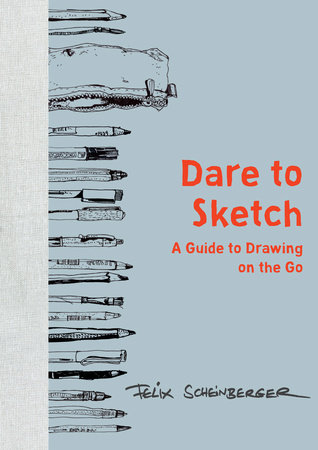Excerpt
Dare to Sketch
Why use a sketchbook?The entry of digital media into all spheres of design and artistic work has narrowed the world of designers, artists, and illustrators to a very small space: our desks. The consequence of this is that we lose a little of our contact with the outside world. We sit at the computer and when we want to draw a subject from outside, we simply google it.
The book you are holding is an attempt at something else. First of all, it contains instructions for drawing and sketching. It deals with the basics and tips and especially the fun of sketching. In addition, this book aims to convey that drawing is a medium that opens up new and larger spaces: spaces in our inner world and in the outside world. Drawing encompasses imagination and knowledge and is one of the few artistic fields in which we experience our subjects on location firsthand. By drawing things, we reflect reality anew. We are no longer processing someone else’s images, but going out into the world and looking at it with our own eyes. A sketchbook enables us to enhance our perspective and thereby enhance our world.
In addition, there is something authentic and personal about drawings. If we only google subjects, we are faced with the problem that we are all using the same images, narrowing our view of the world through the hierarchic funneling process of search engines.
We are presently experiencing a tremendous renaissance in drawing. The genuine is in demand. The vast possibilities of image processing have damaged the credibility of photography. Drawings are enjoying a boom because they are authentic. We artists vouch for our drawings. By doing and experiencing it ourselves, we personally guarantee the authenticity of our pictures. The obvious subjectivity and intimacy of drawn pictures make the medium paradoxically more “real” than photographs or googled images. This means that drawings also are gaining documentary relevance—which leads us to the sketchbook.
My sketchbook is something very personal. I draw in it for me and not for others; I use it to describe my world and my life. I am interested in the world I live in, and in a conscious and prolonged process that lasts longer than that of taking a snapshot. I deal with the world. Drawing is also a sensual process: we draw people differently when we associate an odor with them. A meal that we draw will look different if it doesn’t taste good, and we will draw our own dog differently than some unknown animal.
A sketchbook is just the right place to implement these impressions: it is a personal, human medium. And therein lies its gains—for us, as well as for art. In order to reap our own experiences we have to walk out the door. And when we walk out the door, it’s good to take a sketchbook along.




